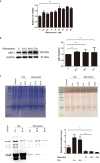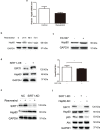Resveratrol regulates Hsp60 in HEK 293T cells during activation of SIRT1 revealed by nascent protein labeling strategy
- PMID: 35517847
- PMCID: PMC9034730
- DOI: 10.29219/fnr.v66.8224
Resveratrol regulates Hsp60 in HEK 293T cells during activation of SIRT1 revealed by nascent protein labeling strategy
Abstract
Background: Resveratrol, a well-known natural compound and nutrient, activates the deacetylation ability of SIRT1, demonstrating p53-dependent apoptosis functions in many diseases. However, the nascent proteomic fluctuation caused by resveratrol is still unclear.
Objective: In this study, we investigated the effect of resveratrol on the nascent proteome and transcriptome initiated by SIRT1 activation, and we explored the mechanism of resveratrol in HEK 293T cells.
Methods: Bioorthogonal noncanonical amino acid tagging (BONCAT) is a method used to metabolically label nascent proteins. In this strategy, L-azidohomoalanine (AHA) was used to replace methionine (Met) under different conditions. Taking advantage of the click reaction between AHA and terminal alkyne- and disulfide-functionalized agarose resin (TAD resin), we were able to efficiently separate stimulation responsive proteins from the pre-existing proteome. Resveratrol responsive proteins were identified by Liquid Chromatograph-Mass Spectrometer/Mass Spectrometer (LC-MS/MS). Furthermore, changes in mRNA levels were analyzed by transcriptome sequencing.
Results: Integrational analysis revealed a resveratrol response in HEK 293T cells and showed that Hsp60 was downregulated at both the nascent protein and mRNA levels. Knockdown of SIRT1 and Hsp60 provides evidence that resveratrol downregulated Hsp60 through SIRT1 and that Hsp60 decreased p53 through the Akt pathway.
Conclusions: This study revealed dynamic changes in the nascent proteome and transcriptome in response to resveratrol in HEK 293T cells and demonstrated that resveratrol downregulates Hsp60 by activating SIRT1, which may be a possible mechanism by which resveratrol prevents p53-dependent apoptosis by regulating Hsp60.
Keywords: Hsp60; SIRT1; nascent proteome; resveratrol; transcriptome.
© 2022 Tian Su et al.
Conflict of interest statement
The authors declare no conflict of interest. This research was supported by research grants from the National Natural Science Foundation of China (grant number 31670781) and Innovation Capability Support Program of Shaanxi Province (grant numbers 2018PT-28, 2017KTPT-04).
Figures





Similar articles
-
Systematic Insight of Resveratrol Activated SIRT1 Interactome through Proximity Labeling Strategy.Antioxidants (Basel). 2022 Nov 25;11(12):2330. doi: 10.3390/antiox11122330. Antioxidants (Basel). 2022. PMID: 36552538 Free PMC article.
-
A terminal alkyne and disulfide functionalized agarose resin specifically enriches azidohomoalanine labeled nascent proteins.J Chromatogr B Analyt Technol Biomed Life Sci. 2021 Feb 15;1165:122527. doi: 10.1016/j.jchromb.2021.122527. Epub 2021 Jan 7. J Chromatogr B Analyt Technol Biomed Life Sci. 2021. PMID: 33486215
-
In-depth quantitative proteomic analysis of de novo protein synthesis induced by brain-derived neurotrophic factor.J Proteome Res. 2014 Dec 5;13(12):5707-14. doi: 10.1021/pr5006982. Epub 2014 Oct 13. J Proteome Res. 2014. PMID: 25271054 Free PMC article.
-
Regulation of FOXOs and p53 by SIRT1 modulators under oxidative stress.PLoS One. 2013 Sep 11;8(9):e73875. doi: 10.1371/journal.pone.0073875. eCollection 2013. PLoS One. 2013. PMID: 24040102 Free PMC article.
-
The controversial links among calorie restriction, SIRT1, and resveratrol.Free Radic Biol Med. 2011 Jul 15;51(2):250-6. doi: 10.1016/j.freeradbiomed.2011.04.034. Epub 2011 Apr 22. Free Radic Biol Med. 2011. PMID: 21569839 Review.
Cited by
-
Molecular Chaperonin HSP60: Current Understanding and Future Prospects.Int J Mol Sci. 2024 May 17;25(10):5483. doi: 10.3390/ijms25105483. Int J Mol Sci. 2024. PMID: 38791521 Free PMC article. Review.
-
Bridging the molecular and clinical aspects of resveratrol in Alzheimer's disease: a review.3 Biotech. 2025 Sep;15(9):284. doi: 10.1007/s13205-025-04451-x. Epub 2025 Aug 6. 3 Biotech. 2025. PMID: 40777747 Free PMC article. Review.
-
Systematic Insight of Resveratrol Activated SIRT1 Interactome through Proximity Labeling Strategy.Antioxidants (Basel). 2022 Nov 25;11(12):2330. doi: 10.3390/antiox11122330. Antioxidants (Basel). 2022. PMID: 36552538 Free PMC article.
References
-
- Tyagi A, Singh RP, Agarwal C, Siriwardana S, Sclafani RA, Agarwal R. Resveratrol causes Cdc2-tyr15 phosphorylation via ATM/ATR–Chk1/2–Cdc25C pathway as a central mechanism for S phase arrest in human ovarian carcinoma Ovcar-3 cells. Carcinogenesis 2005; 26(11): 1978–87. doi: 10.1093/carcin/bgi165 - DOI - PubMed
LinkOut - more resources
Full Text Sources
Research Materials
Miscellaneous

